Physical Address
304 North Cardinal St.
Dorchester Center, MA 02124
The development of the reproductive system is closely integrated with the primitive urinary organs in both males and females, as they share similar common tubular structures enabling both uresis and gamete transport. In addition to the nephric structures, the intermediate mesoderm on both sides of the dorsal body wall gives rise to a gonadal ridge. By the sixth week, the germ cells migrating from the yolk sac begin to arrive in the mesenchyme of the dorsal body wall. The arrival of germ cells in the area just medial to the mesonephroi at the 10th thoracic segment induces the coelomic epithelium to generate somatic support cells and interstitial stromal cells. Somatic support cells will differentiate into Sertoli cells in the male and follicle cells (or granulosa cells) in the female. During the same period, a new pair of ducts, the paramesonephric (Müllerian) ducts , form in the dorsal body wall from coelomic epithelium just lateral to the mesonephric ducts.
The sexual differentiation of genetic males begins at the end of the sixth week, when a specific gene on the Y chromosome (SRY) is expressed in the somatic support cells. Embryos in which this gene is not expressed develop as females. The product of this gene, called the SRY protein , initiates a developmental cascade that leads to formation of the testes, the male genital ducts and associated glands, the male external genitalia, and the entire constellation of male secondary sex characteristics. The SRY protein exerts autonomous control of somatic support cell development into pre-Sertoli cells . Sertoli cells induce the differentiation of a subset of interstitial stromal cells into Leydig cells and peritubular myoepithelial cells. Sertoli cells then envelop the germ cells and, together with myoepithelial cells, organize into testis cords (future seminiferous tubules ). The deepest portions of the somatic support cells in the developing gonad, which do not contain germ cells, differentiate into the rete testis . The rete testis connects with a limited number of mesonephric tubules and canalizes at puberty to form conduits connecting the seminiferous tubules to the mesonephric duct. These nephric tubules become the efferent ductules of the testes, and the mesonephric ducts become the epididymides (singular, epididymis ) and vasa deferentia (singular, vas deferens ). The paramesonephric ducts degenerate. During the third month, the distal vas deferens sprouts the seminal vesicle , and the prostate and bulbourethral glands grow from the adjacent pelvic urethra. Simultaneously, the indifferent external genitalia (consisting of paired urogenital and labioscrotal folds on either side of the urogenital plate and an anterior genital tubercle ) differentiate into the penis and scrotum . Late in fetal development, the testes descend into the scrotum through the inguinal canals .
Because genetic females lack a Y chromosome, they do not produce SRY protein. Hence, the somatic support cells do not form Sertoli cells but rather differentiate into follicle cells that surround the germ cells to form primordial follicles of the ovary. The mesonephric ducts degenerate, and the paramesonephric ducts become the genital ducts. The proximal portions of the paramesonephric ducts become the uterine tubes (or oviducts or Fallopian tubes ). Fusion of the distal portions of the ducts gives rise to the uterus . The vagina is formed from the vaginal plate , an outgrowth of the urogenital sinus. The indifferent external genitalia develop into the female external genitalia: the clitoris and the paired labia majora and minora .
A couple, expecting a boy based on prenatal ultrasound, is surprised when told by the delivery room nurse that they, instead, have a baby girl. Then some confusion seems to ensue among the caregivers. Later, a doctor from the nursery arrives and informs the family that their child has “ambiguous genitalia,” with an enlarged clitoris that was likely confused with a penis on the ultrasound. She tells them that the genitals look more like a girl’s than a boy’s, with a separate urethra and vagina, but that there is partial fusion of the labia with what may be testes being palpable in the groin area. She explains that further testing will be needed to determine the infant’s sex.
The family is visited by several doctors over the next 2 days, including specialists in urology, endocrinology, and genetics. They hear, variously, that the child should be “thought of as a girl,” or that the child is “a boy but may need to be raised as a girl.” They hear terms that are new to them, like “intersex” and “undervirilized.” A battery of tests is done. These include laboratory tests on blood that show normal testosterone and luteinizing hormone levels and an ultrasound that shows no cervix, uterus, or uterine tubes. Gonads, likely testes, are found in the inguinal canal. Later in the week, they find out that their child has a “Y” chromosome (46,XY) and is, therefore, genetically, a boy. Further tests (such as measuring androgen response in skin fibroblasts) confirm the diagnosis of androgen insensitivity syndrome (AIS). Males with AIS (also known as testicular feminization) have mutations in the androgen receptor gene and are unable to respond appropriately to testosterone during development.
Options for sex assignment are presented to the baby’s parents. One is male sex assignment. Although this choice would be consistent with the karyotype, it would involve multiple surgeries in childhood and adolescence, along with testosterone treatment (the response to androgens usually is not completely absent). Another would be female sex assignment, which involves estrogen therapy along with surgery in childhood or puberty to remove the gonads, enlarge the vaginal opening, and reduce the size of the clitoris. With either option, there is the risk that the child will be uncomfortable with gender identity later in life. Given all the uncertainties, the parents find it difficult to commit to a gender assignment and decide on a third option: to make a temporary assignment of female, but to wait to consider surgery until the child is old enough to make her own decisions.

![]()
Animations are available online at StudentConsult.
Sex determination and manifestation begin with genetic sex determination (i.e., 46,XX or 46,XY), which occurs at fertilization (covered in Chapter 1 ). The sexual genotype is responsible for directing gonadal development (i.e., testis versus ovary). This in turn directs reproductive tract (internal organs) and external genitalia development. Genotypic, gonadal, and phenotypic sex assignments may be discordant. Although steady progress has been made in our understanding of the molecular and developmental mechanisms responsible for sex determination and genital development, approximately 75% of the genetic alterations responsible for human sex ambiguity are still unresolved.
In individuals of both sexes, formation and differentiation of the gonads begin with the arrival of primordial germ cells in the intermediate mesoderm. As discussed in Chapter 1 , primordial germ cells normally migrate from the yolk sac via the dorsal mesentery to populate the mesenchyme of the posterior body wall in an area near the 10th thoracic level during the fifth week ( Fig. 16.1A ). There, they move to the area adjacent to the coelomic epithelia, located just medial, ventral, and superior to the developing mesonephric kidneys. In response, the coelomic epithelia proliferate, thicken, and, together with the primordial germ cells, form a pair of genital ridges ( Figs. 16.1, 16.2 ).

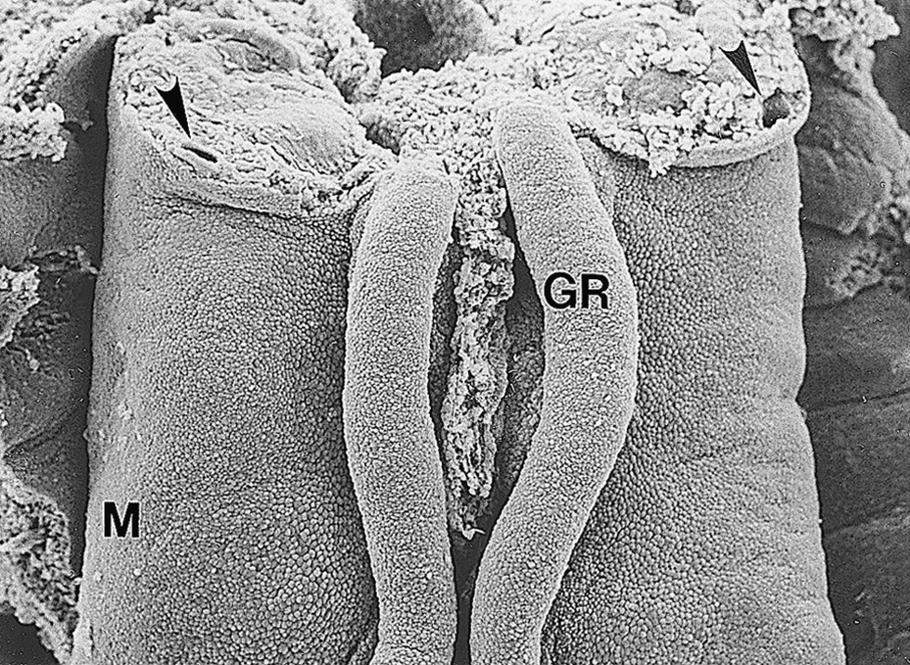
During the sixth week, cells derived from each coelomic epithelium form somatic support cells and interstitial stromal cells (see Fig. 16.1D ). Somatic support cells completely invest the germ cells and are essential for germ cell development within the gonad; if these cells do not invest the germ cells, the germ cells degenerate. After the sixth week, these somatic support cells pursue different fates in males and females.
Also during the sixth week, a new pair of ducts, the paramesonephric ducts (or Müllerian ducts ), begin to form just lateral to the mesonephric ducts in both male and female embryos (see Fig. 16.1B–D) . These ducts arise by the craniocaudal invagination of a ribbon of thickened proliferating coelomic epithelial cells extending from the third thoracic segment caudally to the posterior wall of the urogenital sinus. The caudal tips of the paramesonephric ducts then grow to connect with the developing pelvic urethra just medial to the openings of the right and left mesonephric ducts. The caudal tips of the two paramesonephric ducts adhere to each other just before they contact the developing pelvic urethra. The cranial ends of the paramesonephric ducts form funnel-shaped openings into the coelom. The further development of the paramesonephric ducts in the female is covered later in the chapter.
At the end of the sixth week, the male and female genital systems are indistinguishable in appearance, although subtle cellular differences may already be present. In both sexes, germ cells and somatic support cells are present in the presumptive gonads, and complete mesonephric and paramesonephric ducts lie side by side. The ambisexual or bipotential phase of genital development ends at this point. From the seventh week on, the male and female systems pursue diverging pathways. Table 16.1 lists the homologous male and female adult reproductive cells and organs derived from these embryonic progenitors.
| Presumptive Rudiments | Male Structure | Female Structure |
|---|---|---|
| Indifferent gonad | Testis | Ovary |
| Primordial germ cell | Spermatogonia | Oogonia |
| Somatic support cell | Sertoli cells | Follicle cells |
| Stromal cells | Leydig cells | Thecal cells |
| Gubernaculum | Gubernaculum testis | Round ligament of ovary Round ligament of uterus |
| Mesonephric tubules | Efferent ducts of testis Paradidymis |
Epoöphoron-paroöphoron |
| Mesonephric duct | Appendix of epididymis Epididymis Vas deferens Seminal vesicle Ejaculatory duct |
Appendix vesiculosa Duct of epoöphoron Gartner’s duct |
| Paramesonephric ducts | Appendix of testis | Uterine tubes Uterus |
| Urogenital sinus | Prostatic and membranous urethra Prostatic utricle Prostatic gland Bulbourethral glands |
Vagina Membranous urethra Urethral/paraurethral glands Greater vestibular glands |
| Genital tubercle | Glans penis Corpus cavernosa of penis Corpus spongiosum of penis |
Glans clitoris Corpus cavernosa of clitoris Bulbospongiosum of vestibule |
| Urogenital folds and urogenital and glans plate | Penile urethra/ventral part of penis | Labia minora |
| Labioscrotal folds | Scrotum | Labia majora |
As detailed in Chapter 1 , genetic females have two X sex chromosomes, whereas genetic males have an X and a Y sex chromosome. Although the pattern of sex chromosomes determines the choice between male and female developmental paths, the subsequent phases of sexual development are controlled not only by sex chromosome genes but also by hormones and other factors, most of which are encoded on autosomes .
A single sex-determining factor seems to control a cascade of events leading to male development. This sex-determining transcription factor is encoded by the SRY (SEX-DETERMINING REGION OF THE Y CHROMOSOME) gene. When this transcription factor is expressed in the somatic support cells of the indifferent presumptive gonad, male development is triggered. This step is referred to as gonadal sex determination . If the factor is absent or defective, female development occurs ( Fig. 16.3 ). Thus, femaleness has been described as the basic developmental path for the human embryo. However, it should be emphasized that claiming that ovarian development and femaleness is a passive (i.e., default), rather than active, process, is a gross oversimplification (covered later in the chapter).

![]()
Animations are available online at StudentConsult.
The first event in male genital development is the expression of SRY protein within the somatic support cells of the XY gonad ( Figs. 16.3, 16.4 ). Under the influence of this factor, somatic support cells begin to differentiate into Sertoli cells and envelop the germ cells ( Figs. 16.3, 16.5 ). If SRY is absent (i.e., in XX gonads), somatic support cells differentiate into ovarian follicle cells that envelop the germ cells (see Figs. 16.3, 16.5 ).

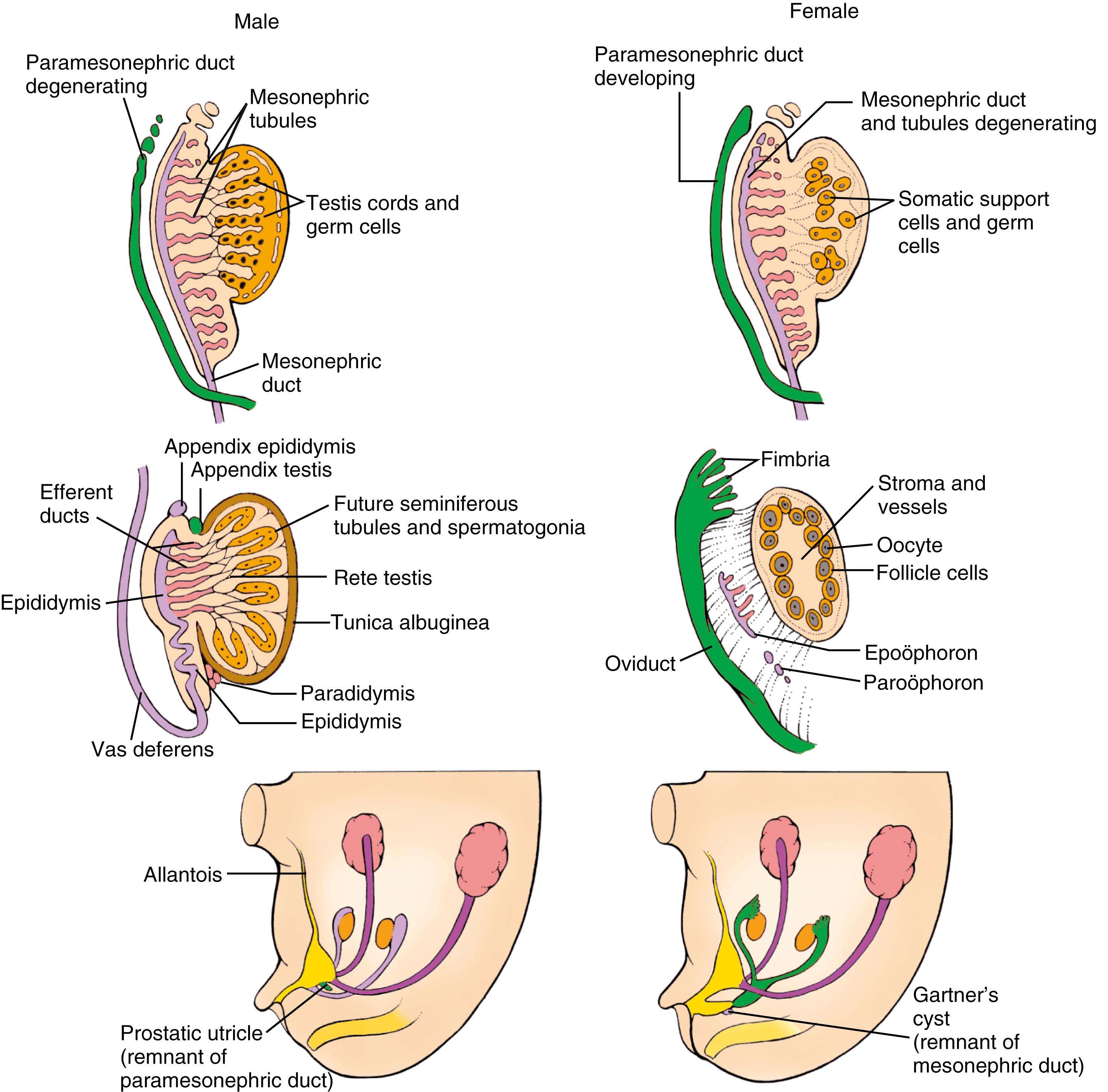
SRY is a single-copy gene located on the Y chromosome. The SRY gene product is a transcription factor that is activated only for a short period within gonadal somatic support cells and likely upregulates testis-specific genes and represses ovarian genes (covered in the following “In the Research Lab”). SRY expression is first detected between days 41 and 44 postovulation and remains detectable there until day 52.
During the seventh week, the differentiating Sertoli cells, together with interstitial cells of the gonad, organize to form testis cords , enclosing germ cells in the center of these cords ( Figs. 16.3, 16.5, 16.6 ). The testis cords become canalized at puberty and differentiate into a system of seminiferous tubules . In the region adjacent to the mesonephros and devoid of germ cells, Sertoli cells organize into a set of thin-walled ducts called the rete testis (see Fig. 16.6 ). The rete testis, which connects the seminiferous tubules with a limited number of mesonephric tubules (future efferent ductules), canalizes at puberty to form a conduit connecting the seminiferous tubules to the mesonephric ducts. The mesonephric ducts later develop into the epididymides (singular, epididymis ), spermatic ducts or vasa deferentia (singular, vas deferens ), and seminal vesicles in the male (covered later).
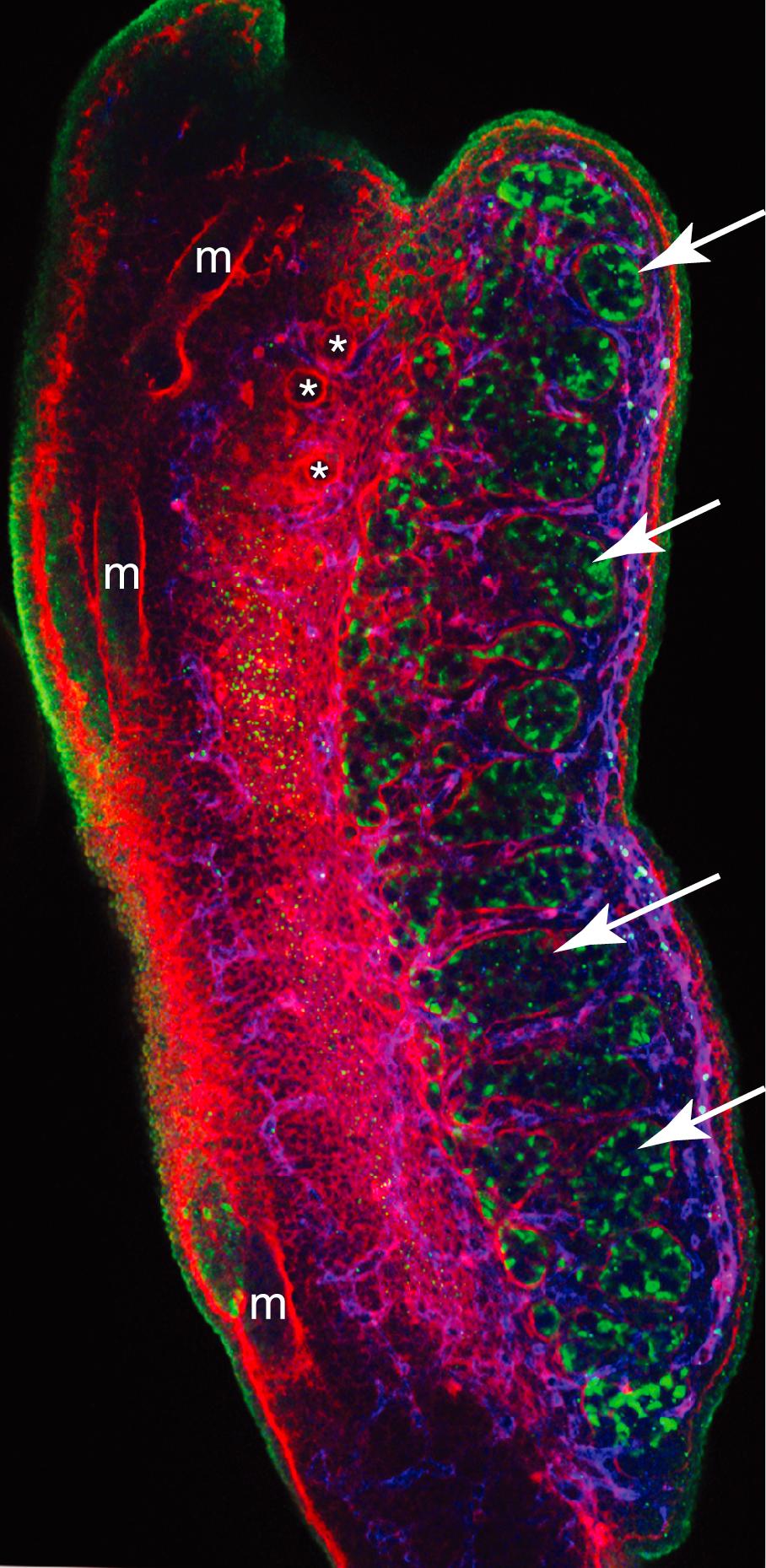
During the seventh week, the testes begin to round up, reducing their area of contact with the mesonephros (see Figs. 16.3, 16.5, 16.6 ). As the testes continue to develop, the coelomic epithelium is separated from the testis cords by an intervening layer of connective tissue called the tunica albuginea.
Although the mechanism has not been elucidated, it is clear that direct cell-to-cell contact between Sertoli cells and primordial germ cells within the gonadal ridge plays a key role in the development of the male gametes. This interaction occurs shortly after the arrival of the primordial germ cells in the region of the presumptive genital ridge. It has the immediate effect of inhibiting further mitosis of the germ cells and preventing them from entering meiosis. No further development of the germ cells occurs until about 3 months after birth, when they differentiate into type A spermatogonia. The remaining phases of male gametogenesis—further mitosis, differentiation into type B spermatogonia, meiosis, and spermatogenesis—are delayed until puberty (covered in Chapter 1 ).
Much of what we have learned regarding the molecular and cellular mechanisms involved in gonad development stems from analyses of mouse mutants and genotype-phenotype correlations with humans who have disorders in sex development. Several genes are required for the early formation of the indifferent gonad, including Wt1, Nr5a1 (nuclear receptor subfamily 5, group A, member 1), Emx2, Lim homeobox protein-9 (Lhx9), and Gata-binding protein-4 (Gata4). Several of these genes, in addition to being necessary for initial formation of the indifferent gonad, are required for subsequent expression of Sry and Sry-targeted genes ( Fig. 16.7 ). For instance, mutations in WT1 and NR5A1 in humans result in malformed gonads and ambiguous genitalia.
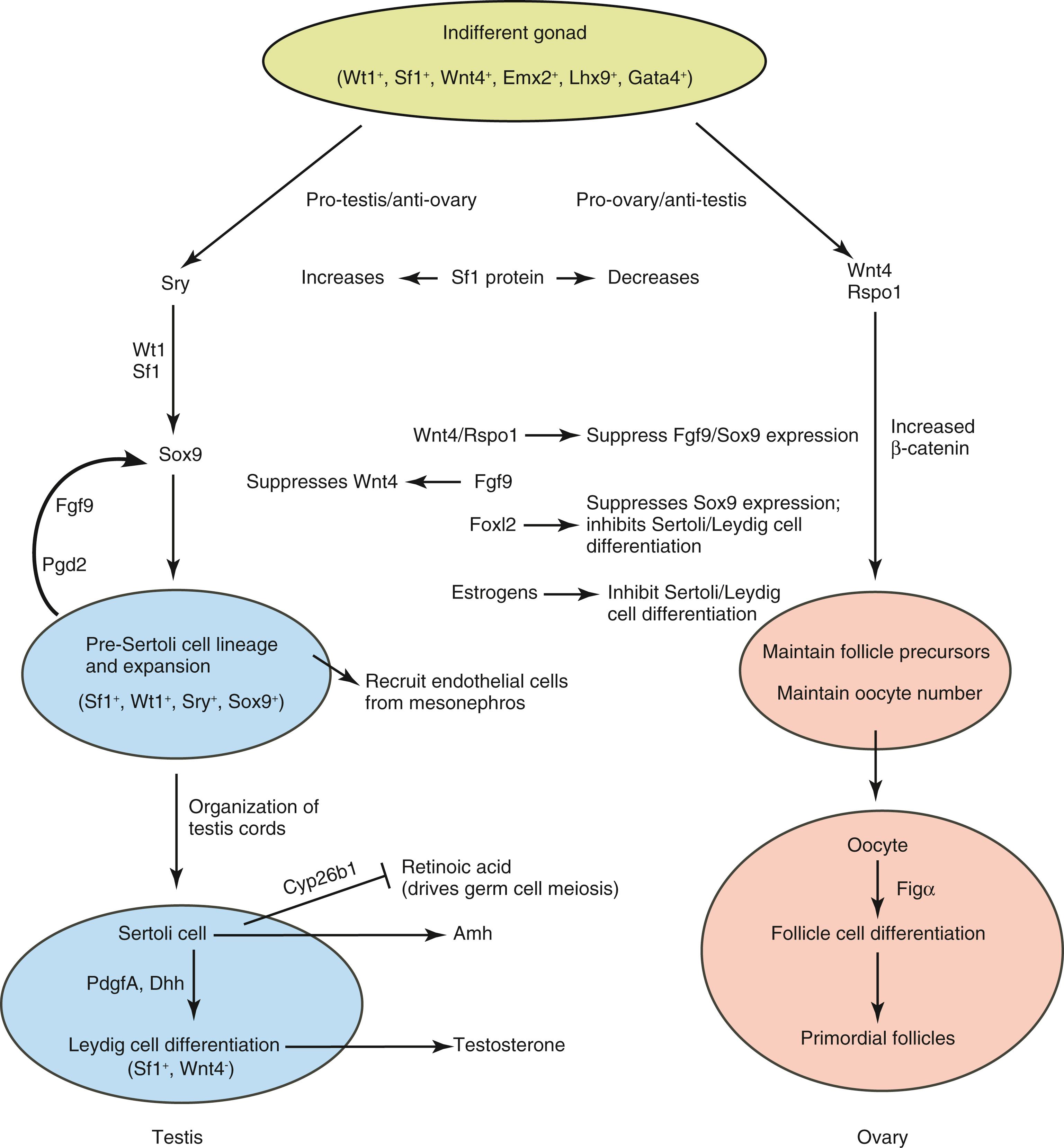
The Sry gene is instrumental in sex determination by its regulation of Sox9 (Sry-related HMG box-9) expression. In the indifferent gonad, Sox9 is weakly expressed in both XX and XY mouse embryos. In XY mice, Sox9 is upregulated just after the expression of Sry in pre-Sertoli cells ( Figs. 16.7, 16.8A, 16.9 ). XY mice with a conditional knockout for Sox9 lack testis cords, do not form Sertoli cells, and express female-specific markers within the gonad. Upregulation of Sox9 expression in XX gonads can also lead to testicular development. Humans with heterozygotic mutations inactivating SOX9 develop campomelic dysplasia (a severe limb long-bone defect covered in Chapter 8 ; Sox9 has an important role in cartilage development, which is also covered in Chapter 8 ). Almost 75% of XY patients with campomelic dysplasia exhibit some degree of sex reversal (i.e., female development), whereas XX patients exhibiting campomelic dysplasia have normal gonads. Moreover, XX individuals with chromosomal duplications in the SOX9 gene develop as males. These observations strongly suggest that SRY effects on sex determination are conveyed through the activation of SOX9.

Primordial germ cells respond very differently to the gonadal environment depending on sex. Upon entering the gonad, primordial germ cells proliferate. In males, the primordial germ cells become surrounded by pre-Sertoli cells and enter mitotic arrest. In females, the primordial germ cells continue mitosis a bit longer and then enter meiosis and quickly arrest. Why germ cells in males do not begin meiosis is unclear, but recent studies in mice suggest they are protected from the effects of retinoic acid generated within the mesonephros when surrounded by Sertoli cells (Sertoli cells express Cyp26b1, a gene coding for an enzyme that metabolizes retinoic acid). What directs male primordial germs cells into mitotic arrest is unknown but may include prostaglandin D2 (Pgd2) and the protein encoded by the Tdl gene (a defensin-like gene mentioned in Chapter 1 ).
Sertoli cells act as the main organizing center for testis development because they direct lineage specification and differentiation of other cells within the gonad. In mice, pre-Sertoli cells expressing Sry are capable of initiating the recruitment of other non-Sry expressing cells into the Sertoli cell lineage. Pre-Sertoli cells produce Fgf9, which mediates Sertoli cell precursor proliferation and maintains Sox9 expression in these cells (covered later in the chapter), and Pgd2, which further upregulates Sox9 expression; both of these reinforce male gonadal development through a positive autoregulatory feedback loop maintaining high Sox9 levels ( Figs. 16.7, 16.8 ).
What is the origin of the initial Sertoli cell population? Lineage-tracing studies in mice show that the earliest Sertoli cell precursors delaminate from the coelomic epithelium of the genital ridge, rather than arising from the mesonephric/gonadal ridge mesenchyme (although additional pre-Sertoli cells may be recruited from the mesonephros by pre-Sertoli cells within the gonadal ridge). Moreover, these experiments found that an unidentified interstitial cell population of unknown function also delaminates from the same epithelium. Studies suggest that these two epithelial-derived lineages are set apart by differences in steroidogenic factor 1 (Sf1) protein levels, a protein encoded by the Nr5a1 gene. Nr5a1 is expressed in the forming suprarenal gland and early somatic cells of both early XX and XY gonads. In XX mice, the gonadal level of Sf1 protein soon decreases, but in XY mice a high level is retained in early Sertoli and Leydig cells (where it promotes anti-Müllerian hormone production by Sertoli cells and testosterone production by Leydig cells). Studies in mice suggest that a proliferating, highly expressing Sf1 subset of coelomic epithelial cells delaminates first and that these cells give rise to pre-Sertoli cells (see Fig. 16.8A ). In the absence of Sry, these delaminating cells do not differentiate into Sertoli cells but rather take on a follicle cell lineage (see Fig. 16.8B ). Newly formed pre-Sertoli cells, now expressing Sry, Sox9, and Fgf9, then signal low Sf1-expressing coelomic epithelial cells to divide, delaminate, and generate interstitial cells (see Fig. 16.8A ). These results are consistent with observations showing that mutations in NR5A1 in humans result in XY gonadal dysgenesis, and that dose-dependent levels of Sf1 protein mediate temperature-dependent sex determination of the bipotential (indifferent) gonads in some vertebrates (e.g., in some reptiles and birds).
The coelomic epithelium is not the only source of cells within the developing gonad. Cells are recruited into the gonadal ridge from the mesonephros by signals emanating from Sf1-positive pre-Sertoli cells (the nature of which is unknown; see Figs. 16.7, 16.8A ). These immigrating cells include endothelial cells that are critical for gonadal development. At one time, precursors of myoepithelial cells were thought to be included in this immigrating group of cells, but recent studies show that they are not. Rather, myoepithelial precursor cells seem to be induced from within the gonad stromal mesenchymal population. However, organization of testis cords is dependent on endothelial cell immigration from the mesonephric mesenchyme, as perturbation of their migration and ability to form blood vessels blocks testis cord formation (see Fig. 16.9 ). The myoepithelial progenitors, together with the Sertoli cells and germ cells, then organize into testis cords.
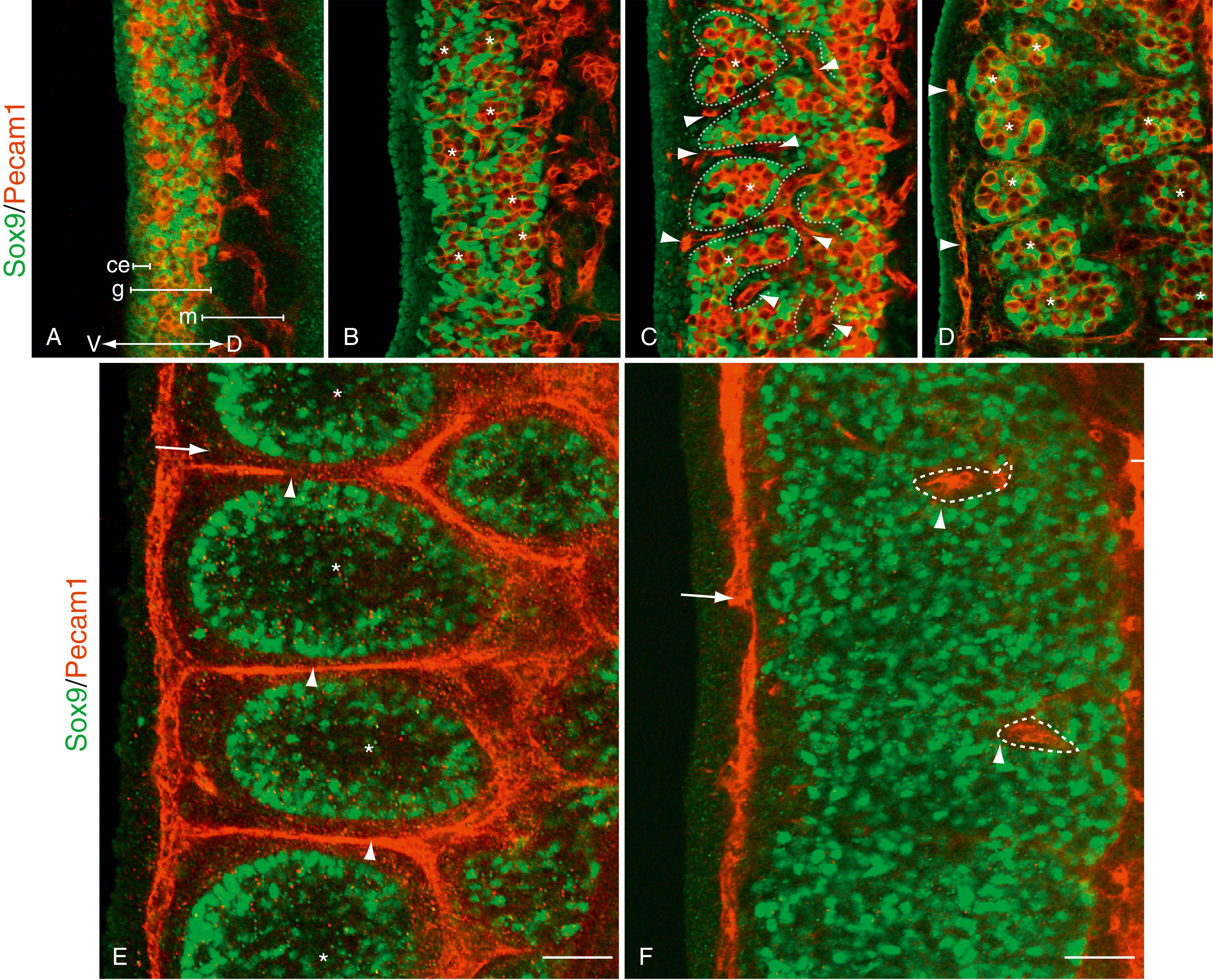
![]()
Animations are available online at StudentConsult.
As pre-Sertoli cells begin their morphologic differentiation in response to SRY, they also begin secreting a glycoprotein hormone called anti-Müllerian hormone (AMH) or Müllerian-inhibiting substance (MIS) . AMH is a member of the TGFβ family and is expressed specifically by Sertoli cells, beginning in humans at about week 8, causing the paramesonephric ducts to rapidly regress between the 8th and 10th weeks (see Figs. 16.4, 16.5, 16.8 ). Nevertheless, small paramesonephric duct remnants can be detected in the adult male, including a small cap of tissue associated with the testis, called the appendix testis , and an expansion of the prostatic urethra, called the prostatic utricle (see Fig. 16.5 ). In female embryos, as described later, the paramesonephric ducts do not regress.
Amh signaling acts indirectly through interactions with the Amh type 2 receptor (Amhr2; also known as Misr2) on mesenchymal cells surrounding the paramesonephric duct, rather than directly on the epithelium of the duct (see Fig. 16.8A ). Upon receptor activation, mesenchymal-to-epithelial signaling induces paramesonephric duct regression. Continual reciprocal epithelial-to-mesenchymal signaling is important for maintaining Amhr2 expression in the mesenchyme because, in the absence of Wnt7a expressing duct epithelium, Amhr2 expression is lost and paramesonephric derivatives are inappropriately retained in the male. AMH and AMHR2 gene mutations have been identified in human males and result in features typical of persistent Müllerian duct syndrome (covered later) including cryptorchidism (undescended testis) or ectopic testes with inguinal hernias.
Recently, another Amh receptor group, the Amh receptor type 1 (Amhr1) receptor group, has been identified based on Amh being a Tgfβ/Bmp family member. Studies have found Alk2, Alk3 (or Bmpr1a), and Alk6 also serve as Amhr1 receptors. When these receptors are knocked out in male mice, or if their signaling is blocked within the paramesonephric duct mesenchyme, Amh-induced paramesonephric duct regression also no longer occurs.
What downstream targets of Amh signaling within the mesenchyme might be responsible for loss of the ductal epithelium? Few have been found, but one might be matrix metalloproteinase type 2 (Mmp2), an extracellular protease (see Fig. 16.8A ) that degrades several basement membrane components and releases bioactive peptides and growth factors from the extracellular matrix. Soon after Amh signaling occurs in the mesenchyme, cells of the paramesonephric duct begin undergoing apoptosis, but only after there is evidence of basement membrane degradation. Increases in Mmp2 expression parallel the appearance of Amhr2 expression, and in Amh-deficient male mice, upregulation of Mmp2 does not occur. In addition, general synthetic inhibitors of Mmp enzymatic activity repress Amh-induced paramesonephric duct regression in vitro (however, specifically blocking Mmp2 expression using antisense technologies only partially represses regression, suggesting other Mmps are involved). Thus by degrading basement membrane or releasing proapoptotic signals, Mmps (including Mmp2) may promote Amh-dependent regression of paramesonephric duct.
Individuals who are 46,XY and have mutations in AMH or AMH RECEPTOR genes exhibit features typical of persistent Müllerian duct syndrome because the paramesonephric (Müllerian) ducts fail to regress. These individuals develop structures that are derived from the paramesonephric duct, in addition to those derived from mesonephric duct ( Fig. 16.10 ). Hence, a male with persistent paramesonephric duct syndrome develops a vagina, cervix, uterus, and uterine tubes, as well as vasa deferentia and male external genitalia. The female organs are in their normal position, but the position of the testes varies. In 60% to 70% of cases, both testes lie in the normal position for the ovaries (i.e., within the broad ligament; see Fig. 16.10A ); about 20% to 30% of the time, one testis lies within the inguinal hernial sac (see Fig. 16.10B ); and in other instances, both testes lie within the same inguinal hernial sac (see Fig. 16.10C ). In all cases, the vasa deferentia run along the lateral sides of the uterus.

In the 9th or 10th week, Leydig cells differentiate from somatic interstitial stromal cells derived from the coelomic epithelium (see Figs. 16.7, 16.8 ). These endocrine cells produce the male sex steroid hormone, testosterone , which promotes survival of the mesonephric duct, necessary for development of the male reproductive tract and later for the development of secondary sexual characteristics. At this early stage of development (up to 12 weeks), testosterone secretion is regulated by the peptide hormone chorionic gonadotropin , secreted by the placenta. Later in development, pituitary gonadotropins of the male fetus take over control of synthesizing the masculinizing sex steroids (androgens). Under control of the placental chorionic gonadotropin, both Leydig cell number and testosterone levels peak by 14 to 18 weeks of gestation. Luteinizing hormone receptors on Leydig cells begin appearing at 12 weeks, and there is a concomitant increase in expression of steroidogenic enzymes released by these cells at this time. But after 16 weeks, the number of Leydig cells and levels of steroidogenic enzymes begin falling as gonadotropin control shifts to the pituitary. Pituitary gonadotropin release begins during the second and third trimesters. Mutations affecting Leydig cell differentiation and function, or in genes involved in testosterone synthesis, generally lead to 46,XY disorders of sex development (covered later in this chapter).
Two distinct populations of Leydig cells are responsible for androgen biosynthesis during fetal and postnatal life. Fetal Leydig cells generate testosterone necessary for stimulating male organ development (i.e., to make the epididymis, vas deferens, and seminal vesicles from the mesonephric duct). From testosterone, Leydig cell 5α-reductase generates dihydrotestosterone , needed to induce male urethra, prostate, penis, and scrotum (covered later in the chapter) and for testicular descent into scrotum (see Fig. 16.4 ). However, fetal Leydig cells eventually regress and degenerate late in fetal and early postnatal life. At puberty, a new population of adult Leydig cells differentiates from Leydig progenitor cells residing within peritubular interstitium. Androgens produced by this set of Leydig cells play a major role in masculinizing the brain, mediating male sexual behavior, and initiating spermatogenesis.
Paracrine interactions between Leydig progenitors and Sertoli cells play a central role in fetal and adult Leydig cell differentiation. Both desert hedgehog (Dhh) and PdgfA are released by fetal Sertoli cells; their receptors, patched1 (Ptch1) and Pdgfrα, are expressed by fetal Leydig cells (see Figs. 16.7, 16.8 ). More than 90% of XY mice with null mutations for Dhh exhibit disorders of sex development, and mice deficient in Pdgfrα exhibit abnormal Leydig cell differentiation. Similar phenotypes (including blind vaginas and underdeveloped mesonephric duct derivatives and prostate glands) are found in XY humans with DHH mutations.
Less is known regarding the differentiation of adult Leydig cells. Although the growth factors Dhh and Pdgf seem to be involved as in fetal differentiation of Leydig cells, several hormones are also involved in adult Leydig cell differentiation. In addition, testicular macrophages are somehow required for adult Leydig cell development. If testicular macrophages are absent from the testicular interstitium, Leydig cells fail to develop, suggesting that these macrophages provide essential growth and differentiation factors for Leydig cells. However, the nature of these signals is still unclear.
Between 8 and 12 weeks, the initial secretion of testosterone stimulates mesonephric ducts to transform into a system of organs—the epididymis, vas deferens, and seminal vesicle—that connect the testes with the urethra. These mesonephric derivatives are distinguishable by their morphologies and specific pattern of gene expression even though they are contiguous (see the following “In the Research Lab” entitled “Development of Epididymis, Vas Deferens, and Seminal Vesicles”).
The bulk of the mesonephric duct differentiates into the spermatic duct called the vas deferens (see Fig. 16.5 ). The most cranial end of each mesonephric duct degenerates, leaving a small remnant called the appendix epididymis , and the region of the mesonephric duct adjacent to the presumptive testis differentiates into the convoluted epididymis . During the ninth week, 5 to 12 mesonephric tubules in the region of the epididymis make contact with the cords of the future rete testis. However, it is not until the third month that these epigenital mesonephric tubules actually unite with the presumptive rete testis. The epigenital mesonephric tubules are thereafter called the efferent ductules , and they will provide a pathway from the seminiferous tubules and rete testis to the epididymis. Meanwhile, the mesonephric tubules at the caudal pole of the developing testis (called the paragenital mesonephric tubules ) degenerate, leaving a small remnant called the paradidymis .
The three accessory glands of the male genital system—the seminal vesicle, prostate, and bulbourethral gland—all develop near the junction between the mesonephric ducts and the urethra ( Fig. 16.11 ). The glandular seminal vesicles sprout during the 10th week from the mesonephric ducts near their attachment to the urethra. The portion of the vas deferens (mesonephric duct) between each seminal vesicle and the urethra is thereafter called the ejaculatory duct .

The prostate gland also begins to develop in the 10th week as a cluster of endodermal evaginations that bud from the urethra. These presumptive prostatic outgrowths are induced by the surrounding mesenchyme, the inductive activity of which probably depends on the conversion of secreted testosterone to dihydrotestosterone. The prostatic outgrowths initially form at least five independent groups of solid prostatic cords. By 11 weeks, these cords develop a lumen and glandular acini, and by 13 to 15 weeks (just as testosterone concentrations reach a high level), the prostate begins its secretory activity. The mesenchyme surrounding the endodermally derived glandular portion of the prostate differentiates into the smooth muscle and connective tissue of the prostate.
As the prostate is developing, the paired bulbourethral glands (or Cowper’s glands ) sprout from the urethra just inferior to the prostate. As in the prostate, the mesenchyme surrounding the endodermal glandular tissue gives rise to the connective tissue and smooth muscle of this gland.
Eventually, the secretions of the seminal vesicles, prostate, and bulbourethral glands all contribute to the seminal fluid protecting and nourishing the spermatozoa after ejaculation. It should be noted that these secretions are not necessary for sperm function; spermatozoa removed directly from the epididymis can fertilize oocytes.
Become a Clinical Tree membership for Full access and enjoy Unlimited articles
If you are a member. Log in here